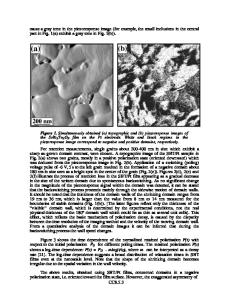Lattice Vibrational Properties of SrBi 2 Ta 2 O 9
- PDF / 190,745 Bytes
- 6 Pages / 612 x 792 pts (letter) Page_size
- 36 Downloads / 431 Views
Lattice Vibrational Properties of SrBi2Ta2O9 Ran Liu1 and Pengdi Han2 1 DigitalDNA Laboratories, Motorola, Mesa, AZ 85202, USA 2 University of Illinois at Urbana-Champaign, Department of Materials Science, Urbana, IL 60801, USA ABSTRACT SrBi2Ta2O9 is one of the layered perovskite ferroelectrics with excellent fatigue resistance and thus has gained great interest of semiconductor industries recently in non-volatile ferroelectric random access memory (FERAM) applications. The understanding of the lattice vibrational properties of this material can provide crucial information on its structure and dielectric behavior. In this work, we carried out Raman spectroscopy study of thin film, powder and single crystal SrBi2Ta2O9. At temperatures above the Curie temperature, all 12 Raman modes expected from the tetragonal (I4/mmm) structure have been observed and assigned to the 4 A1g, 6 Eg and 2 B1g modes based the polarized Raman spectra from the single crystal samples. At lower temperature, the Raman spectra have revealed all 22 A1 modes, but only 3 out of the 20 A2 modes and 5 out of the 42 B1/B2 modes were observed in the ferroelectric phase (A21am). The soft mode was found to be of A1 symmetry and appearing only when light polarization lay in the ab-plane. INTRODUCTION Bismuth layered perovskite ferroelectrics, Bi2Am-1BmO3m+3 (A = Na1+, K1+, Ba2+, Ca2+, Sr2+, Bi3+,... and B = Fe3+, Ti4+, Nb5+, Ta5+, W6+,...), discovered by Aurivillius 47 years ago [1], have recently gained great interest for their potential application to non-volatile ferroelectric random access memories. SrBi2Ta2O9, in particular, has been reported to have excellent fatigue resistance [2]. Detailed investigation of the lattice vibrational properties is required for understanding the structural properties associated with the ferroelectric phase transition and the polarization state and providing a knowledge base for characterization of these materials. In this work, we study the lattice vibrational properties of SrBi2Ta2O9 using Raman spectroscopy and explore the potential application of this technique to characterization of this material. The high temperature paraelectric phase of SrBi2Ta2O9 has a tetragonal structure with space group I 4/mmm (a = 3.895 Å, c = 25.06 Å) [1] (see Figure 1). At temperatures below the Curie temperature (~340°C), small displacive perturbations of the parent tetragonal structure lead to an orthorhombic structure with space group A 21am [3, 4] (a = 5.5306, b = 5.5344, c = 24.9839 Å). Since the orthorhombic distortion is very small, we will first assign the experimental Raman lines using the undistorted parent structure I4/mmm for simplicity. The pseudo-tetragonal unit cell contains one molecular formula, SrBi2Ta2O9, and gives rise to 42 lattice vibrational modes (see Table I) and 39 optical modes. The optical modes at zero wavevector are ΓΤopt = 4A1g + 2B1g + 6Eg + 6A2u + B2u + 7Eu , CC7.5.1
O4 O3
Z Y
O2
x
O1
Figure 1. Unit cell of the tetragonal SrBi2Ta2O9 structure (I4/mmm). Bi
Sr
Ta
O
Table I. Phonon modes in the t
Data Loading...











